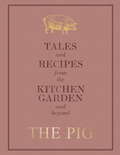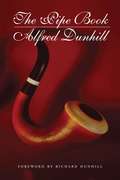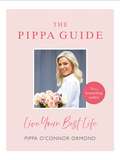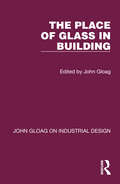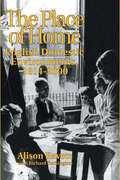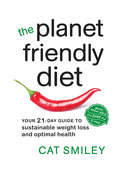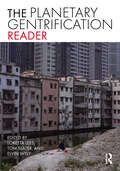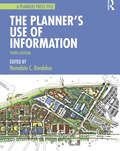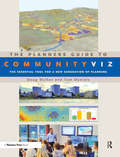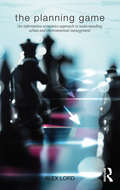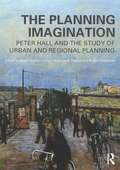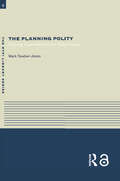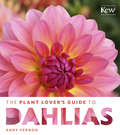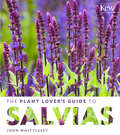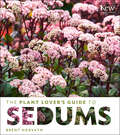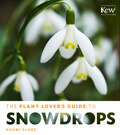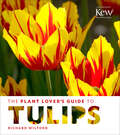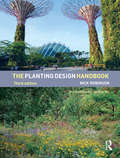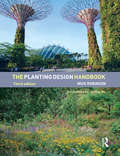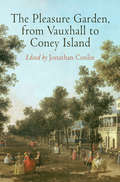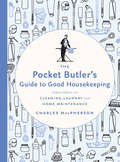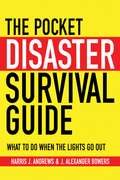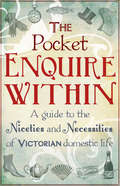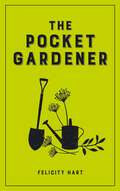- Table View
- List View
The Pig: Tales and Recipes from the Kitchen Garden and Beyond
by Robin HutsonThe Pig is a collection of restaurants with rooms in Hampshire, Devon, Dorset and Somerset - and soon in Kent, West Sussex and Cornwall. Now, everyone can enjoy The Pig from the comfort of their own homes. Among the pages of The Pig you will find an idiosyncratic, seasonal approach to the good life, with delicious recipes, how-to guides, tips, tricks and stories.Inside the pages of The Pig you will find: Classic recipes from Nan's rice pudding to proper fish pie, porchetta, gammon with parsley sauce, devilish devilled kidneys on toast, a right old eton mess and even a pink blancmange bunny.The Pig's Guide to Pigs from identifying different breeds and selecting the best cuts of meat to making your own sausages, crackling and charcuterie. How to pickle, forage and identify edible flowers and suggestions on how to bring the weird and wonderful vegetables, fruits and salads from the garden into the kitchen. Noble wine, simple food from classic cocktails to modern twists and all the best accompaniments. Interior design recreating the comfort and elegance of The Pig at home.Setting the scene, The Pigs top tips on hosting your own festivals, summer feasts and winter gatherings, including creating the perfect playlist to the best recipes to cook outdoors. Praise for The Pigs: Rick Stein: 'Dinner, bed and breakfast at The Pig, any Pig, is a comforting thought of some lovely flavoured pork, a British abundance of vegetables and some fabulous red wine.' The Sunday Times: 'There isn't a trace of cynicism here - just enthusiasm, craft and people who love what they do, creating a place you really, really don't want to leave.' The Financial Times 'Some inherited memory of a weekend with grandparents I never had... a little bohemian, and unbelievably good at cooking.' Tom Parker Bowles 'The Pig revolutionised the country house hotel, creating a true home away from home. No pomp or pretence, just beautiful rooms and magnificent food with produce from their own kitchen gardens. Where The Pig goes, the others follow.'
The Pipe Book: A Guide To Nearly Every Pipe Created
by Alfred DunhillAs a successful London tobacconist in the early 1900s, Alfred Dunhill’s passion for his field led him to begin collecting pipes from all over the world. From his collection he created The Pipe Book, which was first printed in 1924 and has rarely been out of print since. The book is a thorough exploration of every type of pipe—primitive mounds and earthen pipes; more elegant models of ivory, clay, and porcelain; and of course modern briers, cobs, and meerschaums—with in-depth explanations of their uses, structures, and origins, as well as fascinating anthropological discussions on smoking in various cultures.
The Pippa Guide: Live Your Best Life
by Pippa O'Connor Ormond"I think anyone can do anything they want to do. I really believe that."Style icon and savvy businesswoman Pippa O'Connor Ormond believes that anything is achievable if you put your mind to it.In this honest and revealing guide to modern life, Pippa shares some of her personal moments, experiences and life lessons that have shaped her into the person she is today. From excelling at work, to making your house a home, styling your wardrobe and perfecting your beauty routine, nurturing family and friendships while promoting self-care, Pippa will reveal her most valuable tips for bringing positivity and happiness into your life."I'm always practising gratitude. No matter what you have in life, once you are grateful for it, it manifests more. 100%."
The Place of Glass in Building (John Gloag On Industrial Design Ser.)
by John GloagOriginally published in 1943, The Place of Glass in Building is a comprehensive and compact survey of the structural uses of glass in 20th Century architecture. It gives the facts about the physical properties, the possibilities and the limitations of the glass in common use. It also deals with the attributes of specialised and decorative glass and provides detailed descriptions of the principal types which were manufactured in the UK. Intended for architectural students it may also be of interest to architects, for it is a condensed survey of the progress that has been made in this structural and decorative material.
The Place of Home: English domestic environments, 1914-2000 (Planning, History and Environment Series)
by Alison Ravetz Professor Alison Ravetz R. TurkingtonA comprehensive and in-depth history of the 20th century English home, how it has been created, and how it works for people. It focuses on the various influences bearing on the development of domestic space since 1914 and covers both design and housing policy. Current debates from participation to co-operative housing are examined and several themes not previously brought together are linked, e.g. urban development/house design; technology at home/women and home; social meaning of home.
The Placemaker's Guide to Building Community (Earthscan Tools For Community Planning Ser.)
by Nabeel HamdiFrom the author of Small Change comes this engaging guide to placemaking, packed with practical skills and tools that architects, planners, urban designers and other built environment specialists need in order to engage effectively with development work in any context. Drawing on four decades of practical and teaching experience, the author offers fresh insight into the complexities faced by practitioners when working to improve the communities, lives and livelihoods of people the world over. The book shows how these complexities are a context for, rather than a barrier to, creative work. The book also critiques the single vision top down approach to design and planning. Using examples of successful professional practice across Europe, the US, Africa, Latin America and post-tsunami Asia, the author demonstrates how good policy can derive from good practices when reasoned backwards, as well as how plans can emerge in practice without a preponderance of planning. Reasoning backwards is shown to be a more effective and inclusive way of planning forwards with significant improvements to the quality of process and place. The book also offers a variety of methods and tools for analyzing the issues, engaging with communities and other stakeholders for design and settlement planning and for improving the skills of all involved in placemaking. Ultimately the book serves as an inspiring guide, and a distillation of decades of practical wisdom and experience. The resulting practical handbook is for all those involved in doing, learning and teaching placemaking and urban development world-wide.
The Planet Friendly Diet
by Cat SmileyWould you like to lose weight, feel great, and minimize the impact of your eating habits on the environment? The Planet Friendly Diet is a unique, all-inclusive blueprint for a greener lifestyle based on responsible dietary choices. Jump start your journey to optimum health with the all-inclusive twenty-one day meal plan, and then apply the information in the accompanying nutrition guide to transform short-term success into long-term, sustainable results.Leading body-transformation expert and former professional skier Cat Smiley shares her simple step-by-step program for a complete detox and reboot. The diet is meat, dairy, wheat and gluten-free, and comes with a weekly shopping list to ensure zero-waste. All single-portion recipes: Use fresh, every day ingredients Cost less than $5.00 Are under 500 calories Take no more than twenty minutes to prepareWhether you want to give your eating patterns a complete makeover or just kick start a change towards a healthier life, The Planet Friendly Diet will motivate, educate and empower you. Fully-illustrated with mouthwatering images of each internationally inspired recipe, it's like having your very own nutrition coach and personal chef. And not only will yopu lose weight, get fit, and feel great - you'll be contributing to a wider humanitarian cause. Cat Smiley is an award-winning body transformation specialist and owner of Canada's premiere weight-loss retreat for women, Whistler Fitness Vacations. A former world-class skier, she is a philanthropist, nutritionist, and master trainer.
The Planetary Gentrification Reader
by Loretta Lees Tom Slater Elvin WylyGentrification is a global process that the United Nations now sees as a human rights issue. This new Planetary Gentrification Reader follows on from the editors’ 2010 volume, The Gentrification Reader, and provides a more longitudinal (backward and forward in time) and broader (turning away from Anglo-/Euro-American hegemony) sense of developments in gentrification studies over time and space, drawing on key readings that reflect the development of cutting-edge debates. Revisiting new debates over the histories of gentrification, thinking through comparative urbanism on gentrification, considering new waves and types of gentrification, and giving much more focus to resistance to gentrification, this is a stellar collection of writings on this critical issue. Like in their 2010 Reader, the editors, who are internationally renowned experts in the field, include insightful commentary and suggested further reading. The book is essential reading for students and researchers in urban studies, urban planning, human geography, sociology, and housing studies and for those seeking to fight this socially unjust process.
The Planner's Use of Information
by Hemalata C. DandekarFor more than 35 years, planners have depended on The Planner's Use of Information to help them address their information needs. While the ability to manage complex information skillfully remains central to the practice of planning, the variety and quantity of information have ballooned in the last two decades. The methods of accessing and handling information––although often ultimately easier and faster––require new technical savvy. At the same time, planners themselves, and the constituents they serve, have changed. This completely revised and updated third edition of this popular book will serve the new generation of planners who work in a world where social media, cell phones, community-embedded development, and a changing population have revolutionized the practice of planning. Edited again by Hemalata C. Dandekar, with chapters by leading experts in data collection, analysis, presentation, and management, The Planner's Use of Information empowers practitioners to use and address the impacts of twenty-first-century technologies. The book offers a range of methods for addressing many kinds of information needs in myriad situations. It is an invaluable day-to-day resource for practicing planners and an ideal classroom text for courses in planning communication and analytical methods. Illustrations, real-life examples, cartoons, exercises, bibliographies, and lists of online resources enrich the text.
The Planners Guide to CommunityViz: The Essential Tool for a New Generation of Planning
by Doug WalkerWhat does the future look like? Planners wrestle with this question daily as they strive to bring a community's vision of itself to life, in all its complexity. Here is an authoritative and accessible guide to a tool that combines 3-D visualization, data analysis and scenario building to let planners and citizens see the future impacts of a plan or development. The Planners Guide to CommunityViz is the first book to explain how to support planning projects with CommunityViz, GIS-based software that planners around the world are using to help decision-makers, professionals, and the public visualize, analyze, and communicate about development proposals, future growth patterns, and the outcome of particular plans or developments. It shows the planner which tools and techniques to use and how to use them for maximum effectiveness on planning projects large and small. Full of practical examples and case studies, the book shows how CommunityViz can enliven the comprehensive planning process from visioning, to public participation, to values mapping, to build-out analysis. Chapters show how to use CommunityViz to analyze zoning regulations, calculate the costs of community services, and evaluate development proposals requiring design review. In addition, it is applicable to transportation planning, natural-resource planning, land-development suitability assessment, and urban economic development analysis.
The Planning Game: An Information Economics Approach to Understanding Urban and Environmental Management
by Alex LordTrading information is an essential aspect of the negotiations that underpin planning practice across the globe. In this book, Alex Lord uses information economics to outline a way of thinking about these negotiations that places the strategies that actors in the planning game use at the heart of the debate. Dialogue between economics and planning theorists has been, until now, rare. Lord argues that information economics’ tool kit, game theory – including well-known examples such as the Prisoners’ Dilemma, the Stag Hunt game and Follow the Leader – offers an analytical framework ideally suited to unpacking planning processes. This use of game theory to understand how counterparties interact draws together two distinct bodies of literature: firstly the mainstream economics treatment of games in abstract form and, secondly, accounts of actual bargaining in planning practice from a host of international empirical studies. Providing a novel alternative to existing theories of planning, The Planning Game provides an explanation of how agencies interact in shaping the trajectory of development through the application of game theory to planning practice.
The Planning Imagination: Peter Hall and the Study of Urban and Regional Planning (Planning, History and Environment Series)
by Mark Tewdwr-Jones Nicholas A. Phelps Robert FreestoneKnighted in 1998 ‘for services to the Town and Country Planning Association’, and in 2003 named by Her Majesty Queen Elizabeth II as a ‘Pioneer in the Life of the Nation’, Peter Hall is internationally renowned for the breadth and depth of his studies and writings on urban and regional planning. For the last 50 years, he has captured and helped to create the ‘planning imagination’. Here the editors have brought together in five themes a series of critical reflections on Peter’s vast and diverse contributions. Those reflections are provided by colleagues familiar with his work. The five parts are devoted to Peter Hall’s breadth of academic work, covering the history of cities and planning, London, spatial planning, connectivity and mobility, and urban globalization. Finally, as a sixth part, the editors have asked Peter Hall himself to reflect on his career and the sources of his imagination. The story this book tells is not one of a singular, totally consistent theoretical and philosophical view elaborated over several decades. Rather it covers a set of views that necessarily admits signs of Peter’s inconsistency and imperfection over the years – the insights and imperfections that inevitably accompany the exercise of a nonetheless remarkably fertile, restless and inspiring planning imagination.
The Planning Polity: Planning, Government and the Policy Process (RTPI Library Series #Vol. 4)
by Mark Tewdwr-JonesPlanning is not a technical and value free activity. Planning is an overt political system that creates both winners and losers. The Planning Polity is a book that considers the politics of development and decision-making, and political conflicts between agencies and institutions within British town and country planning. The focus of assessment is how British planning has been formulated since the early 1990s, and provides an in-depth and revealing assessment of both the Major and Blair governments' terms of office. The book will prove to be an invaluable guide to the British planning system today and the political demands on it. Students and activists within urban and regional studies, planning, political science and government, environmental studies, urban and rural geography, development, surveying and planning, will all find the book to be an essential companion to their work.
The Plant Lover's Guide to Dahlias (The Plant Lover’s Guides)
by Andy VernonDahlias are the showgirls of the garden. A favorite of floral and landscape designers, they come in a wide range of jewel-like colors—rich reds and vibrant oranges, shocking pinks—and an engaging variation of form and petal shape. The Plant Lover’s Guide to Dahlias is packed with everything you need to know to grow these fantastic flowers including tips on using dahlias in garden design, growth and propagation information, and lists of where to buy the plants and where to view them in public gardens. The bulk of the book is devoted to profiles for over 200 varieties, organized by color, with information on type, height, and spread. Gorgeous color photographs bring the plants to life.
The Plant Lover's Guide to Salvias (The Plant Lover’s Guides)
by John WhittleseySalvias are available in a huge range of sizes, colors, foliage, and hardiness, with over 900 species and hundreds of hybrids. Salvia’s popularity stems from how easy they are to grow, their multiple medicinal and culinary uses, and the vibrancy of their blooms that cover every color in the spectrum from white to nearly black. The Plant Lover’s Guide to Salvias features everything you need to know to grow this vibrant and fragrant plant. Plant profiles of 150 varieties highlight each plant’s type, habitat, size, hardiness, origin, cultivation, and use in the landscape. Additional information includes tips on design, how to grow and propagate salvia, where to view them in public gardens, and where to buy them.
The Plant Lover's Guide to Sedums (The Plant Lover’s Guides)
by Brent HorvathSedums are most popular flowering succulent. They range from groundcovers to large border perennials and are often included in green roof and vertical garden design because of their visual interest and drought tolerance. Sedums changes dramatically with the seasons—in fall, they are rich and earthy while in summer their flowers come in vibrant shades of pink and yellow. The Plant Lover’s Guide to Sedums includes everything you need to know about these beautiful gems. Plant profiles highlight 150 of the best varieties to grow, with information on zones, plant size, soil and light needs, origin, and how they are used in the landscape. Additional information includes designing with sedums, understanding sedums, growing and propagating, where to buy them, and where to see them in public gardens.
The Plant Lover's Guide to Snowdrops (The Plant Lover’s Guides)
by Naomi SladeSnowdrops have a delicate, quiet beauty. Their white bell-shaped petals are striking alone and in a swath, and they are a harbinger of spring. The Plant Lover’s Guide to Snowdrops is the first book to make this group of bulbs accessible to the home gardener. It features profiles of 60 hybrids, species, and cultivars, with information on flowering time, distinguishing features, and ease of cultivation. It addition, it shows how to design with snowdrops, and how to grow and propagate them, also offering tips on where to see snowdrops in public gardens and where to buy them. Each Plant Lover’s Guide in the series is supported by lush, photo-driven design, featuring the most beloved plants and valued expertise of the gardening world in a visual, comprehensive resource.
The Plant Lover's Guide to Tulips (The Plant Lover’s Guides)
by Richard WilfordTulips are one of the most popular spring-flowering bulbs. Available in a huge range of colors and in a wide array of shapes, they’re a mainstay of most spring gardens. They are the focus of festivals worldwide and are a sure sign spring is on the way. The Plant Lover’s Guide to Tulips, by Richard Wilford of the Royal Botanic Gardens Kew, profiles 100 commonly available species and cultivars, and features growing information, recommendations for companion plants, and tips on how to use tulips in the landscape. More than 250 color photographs bring these colorful gems to life.
The Planting Design Handbook
by Nick RobinsonSince the first edition was published in 1992, Nick Robinson's The Planting Design Handbook has been widely used as a definitive text on landscape architecture courses throughout the world. It remains one of the few titles written by a practicing landscape architect and educator who is also a horticulturalist and accomplished plantsman, and which deals with the application of planting design on a large scale in landscape architecture and urban design projects. The Planting Design Handbook is distinctive for its elegant integration of an ecological approach with an understanding of visual and spatial composition. It emphasizes the role of vegetation layers and designed plant communities in complex and diverse plant assemblages for all kinds of sites and uses. This expanded and comprehensively updated third edition still provides a complete examination of principles and practice of design for public, institutional and private landscapes. It takes account of developments in theory and practice, especially in the use of perennials, and reflects a variety of media and approaches current in landscape architecture and design. All chapters have been revised and re-written to ensure updated references and new references have been added. Many new photographs of planting and projects around the world have been included, with examples of current professional drawings to illustrate the design process. It is generously illustrated, including a colour section and the beautifully detailed line drawings of the Chinese architect and painter Jia-Hua Wu.
The Planting Design Handbook
by Nick RobinsonSince the first edition was published in 1992, Nick Robinson's The Planting Design Handbook has been widely used as a definitive text on landscape architecture courses throughout the world. It remains one of the few titles written by a practicing landscape architect and educator who is also a horticulturalist and accomplished plantsman, and which deals with the application of planting design on a large scale in landscape architecture and urban design projects. The Planting Design Handbook is distinctive for its elegant integration of an ecological approach with an understanding of visual and spatial composition. It emphasizes the role of vegetation layers and designed plant communities in complex and diverse plant assemblages for all kinds of sites and uses. This expanded and comprehensively updated third edition still provides a complete examination of principles and practice of design for public, institutional and private landscapes. It takes account of developments in theory and practice, especially in the use of perennials, and reflects a variety of media and approaches current in landscape architecture and design. All chapters have been revised and re-written to ensure updated references and new references have been added. Many new photographs of planting and projects around the world have been included, with examples of current professional drawings to illustrate the design process. It is generously illustrated, including a colour section and the beautifully detailed line drawings of the Chinese architect and painter Jia-Hua Wu.
The Pleasure Garden, from Vauxhall to Coney Island
by Jonathan ConlinSummers at the Vauxhall pleasure garden in London brought diverse entertainments to a diverse public. Picturesque walks and arbors offered a pastoral retreat from the city, while at the same time the garden's attractions indulged distinctly urban tastes for fashion, novelty, and sociability. High- and low-born alike were free to walk the paths; the proximity to strangers and the danger of dark walks were as thrilling to visitors as the fountains and fireworks. Vauxhall was the venue that made the careers of composers, inspired novelists, and showcased the work of artists. Scoundrels, sudden downpours, and extortionate ham prices notwithstanding, Vauxhall became a must-see destination for both Londoners and tourists. Before long, there were Vauxhalls across Britain and America, from York to New York, Norwich to New Orleans.This edited volume provides the first book-length study of the attractions and interactions of the pleasure garden, from the opening of Vauxhall in the seventeenth century to the amusement parks of the early twentieth. Nine essays explore the mutual influences of human behavior and design: landscape, painting, sculpture, and even transient elements such as lighting and music tacitly informed visitors how to move within the space, what to wear, how to behave, and where they might transgress. The Pleasure Garden, from Vauxhall to Coney Island draws together the work of musicologists, art historians, and scholars of urban studies and landscape design to unfold a cultural history of pleasure gardens, from the entertainments they offered to the anxieties of social difference they provoked.
The Pocket Butler's Guide to Good Housekeeping: Expert Advice on Cleaning, Laundry and Home Maintenance (Pocket Butler)
by Charles MacPhersonEveryone's favourite butler is back! Get your home spic and span with Charles MacPherson's expert tips and tricks for everything from polishing silverware to organizing the garage.After over 30 years as a professional butler and household manager, Charles MacPherson knows a thing or two about keeping a home clean and organized. He has poured his vast knowledge and expertise into this pocket-sized volume, perfect for easy day-to-day reference or to guide your next marathon cleaning session.Everything you need to know is here. With step-by-step instructions for cleaning, organizing, and maintaining every room in your home, The Pocket Butler's Guide to Housekeeping comprises information-packed chapters on cleaning, laundry, organization, and more. Wondering how to tackle a fresh stain? Looking for recipes for natural and gentle cleaning products? Want to finally master those crisp hospital corners for making your bed? Look no further than this definitive cleaning caddy companion.With handy checklists for daily, weekly, monthly, and annual cleaning; a complete guide to laundry symbols and fabric types; advice for hosting guests; and even tips for dealing with pests, damage, and long-term maintenance, this is a volume no home should be without.
The Pocket Disaster Survival Guide: What to Do When the Lights Go Out
by Harris J. Andrews J. Alexander BowersWhether it’s a hurricane bearing down on a home near the coast or a power line downed in a snowstorm near a car, are you prepared for these situations? This slim handbook will provide you with all the information you need to ensure that you, your family, and your pets can weather any emergency crisis. Learn the necessity of backing up important documents, how to safely store food and water for more than a day, and how to communicate with your family and emergency personnel should a disaster strike.
The Pocket Enquire Within: A guide to the niceties and necessities of Victorian domestic life
by George ArmstrongWhat is the correct way to carve a partridge?How should leeches be applied?How can egg whites be used to repair broken china?First published in 1856, Enquire Within rapidly became the indispensable guide to Victorian domestic life. Packed with words of wisdom and pithy advice, it covered everything from entertaining and etiquette to household management, and took in considered discussion of such arcane matters as how singing might prevent consumption, and which ointments will remove freckles, not to mention why chess should on no account ever be played at a ball.This new, charmingly illustrated pocket-sized edition contains a selection of hints and tips that not only provide a fascinating insight into the day-to-day life of Victorian Britain, but also, in places, reveal timeless wisdom that we would do well to heed today.
The Pocket Gardener
by Felicity HartBrimming with curious garden lore as well as practical, year-round advice on everything from planting and pruning to growing your own veg and composting, this handy book is the perfect companion for any gardener. Whether you’re seeking inspiration or information, The Pocket Gardener will keep you busy in all seasons.
